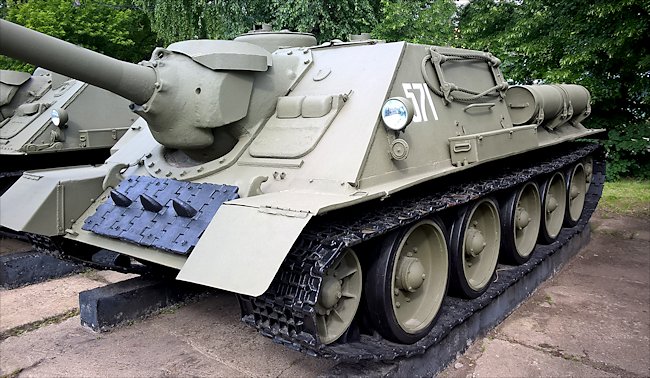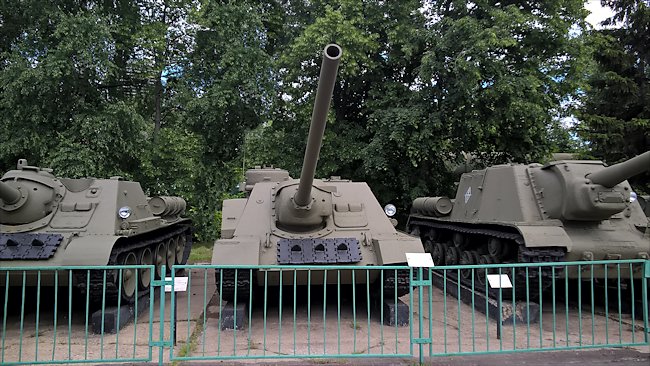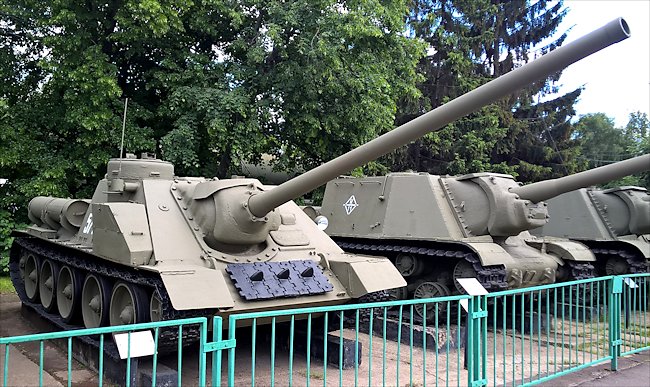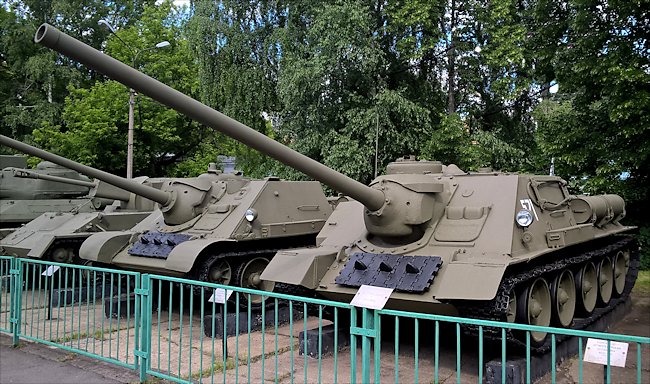SU-100 Tank Destroyer
This WW2 SU-100 Russian Soviet Tank Destroyer self-propelled gun can be found at the Central Armed Forces Museum in Moscow Russia

This WW2 SU-100 Russian Soviet Tank Destroyer self-propelled gun can be found at the Central Armed Forces Museum in Moscow Russia
Location
To get to the Central Armed Forces Museum in Moscow you will find it in the road called Ulitsa Sovetskoy Armii in the north of the city to the left of the Olympic Stadium. The nearest metro station is Dostoevskaya.
Development of the SU-100
Several Soviet self-propelled guns were built in competition with the Joseph Stalin IS tank series. In August 1943 engineers Machonin, Gorlick and Trojanov designed the new SU-85 tank destroyer. Towards the end of 1943 the Uralmashzavod and Chelyabinsk combines built 100 SU-85s, but during the following year a significant increase in the production of this vehicle took place. The SU-85 gained respect during the fighting with German tanks in the Ukraine and Dniepner offensives of 1944.
It took over the tank-destroyer role from the SU-76, which now became relegated to providing artillery fire support to infantry units. The SU-85 closely resembled the older SU-122 in hull configuration, with the gun mounted in a fixed superstructure on the T-34 tank chassis. The gun was a tank adaptation of the 85 mm anti-aircraft gun M-1939. With the introduction in 1944 of the T-34/85 tank, the SU-85 became obsolescent and was reworked with the 85 mm gun D5-S85A (M-1944) anti-tank gun and issued to satellite armies. There was no visible difference between the two guns, although the M-1944 had a greater range and greater armour penetration.

This WW2 SU-100 Tank Destroyer is in the missle between a SU-85 on the left and an SU-152 on the right.
In September 1944 the SU-85 started to be replaced by the SU-100, and by early 1945 it disappeared altogether from the Soviet Army. Around 500 of the new SU-100 tank destroyers were manufactured during early 1944. Garret Underhill wrote , 'With the advent in 1944 of the SU-100, with the new 100 mm gun (adapted from the prewar naval 100/56 high velocity dual-purpose gun) the SU version of the T-34 received far more firepower than its turreted counterpart. As with the SU-85 the gun was laid with a tank-gun type telescope: no panoramic telescopes were provided. No machine-gun was mounted, even for anti-aircraft use. The Soviet self-propelled guns always had both intercom sets and radio; the intercom was more necessary on the SU than on the early T-34 medium, since the former's driver was separated from the vehicle commander. In the T-34/76 both commander and driver were on the left; the commander could use foot signals on the driver's shoulder. In the SUs the commander was off to the right, and on the SU—76 was separated from the driver by the engine and transmission.'

This WW2 SU-100 Russian Soviet Tank Destroyer self-propelled gun can be found at the Central Armed Forces Museum in Moscow Russia
The superstructure was very similar to that of the SU-85 and the hull, running-gear and automotive components were identical to the T-34/85 tank. The armament consisted of the 100 mm field/anti-tank gun Model 1944 (D-IOS). As with the SU-85, no secondary armament was carried. The 100 mm gun had a greatly improved performance over that of the 85 mm gun, firing a high explosive HE shell to a range of 21 ,000 yards. It also fired an armour piercing AP round.
The SU-100 normally carried, on each side towards the rear, two extra fuel tanks. A single headlamp was mounted on the left over the track for night driving. Spare track links were often bolted on the front, together with a long wire towing cable. In action, the rear of the chassis behind the crew compartment was usually piled with wooden ammunition boxes, and stowage. The short whip aerial could be folded to the rear along the side.

This SU-100 at the Central Armed Forces Museum in Moscow Russia is next to a SU-76 and a SU-85 SPG
WW2 tank books

